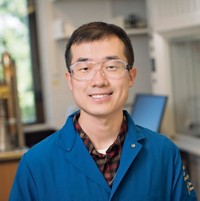×
CEN's 2022 Trailblazers
Tehshik P. Yoon wields light to open new possibilities for organic synthesis
Kelly N. Chacón characterizes enzymes that break down toxic metals
Barbara Belmont is devoted to nurturing the next generation of scientists
Charlie Wand uses simulations to study molecules' behavior
Nancy Scott Burke Williams has unraveled platinum's penchant for making and breaking carbon bonds
Jennifer Petter wants to interfere with RNA to discover new drug targets
Andre Isaacs inspires future chemists on social media and on campus
Alison Wendlandt One on one with Bec Roldan
Raul Navarro One on one with Grace Wang
Polly Arnold explores the chemistry of rare earths and radioactive elements
Carolyn L Ladd One on one with Kirstin S. Bode
Song Lin One on one with Alby J. Joseph
Nicholas Ball One on one with Ali McKnight
Carolyn Bertozzi One on one with Pauline Navals
Melissa Gish One on one with Matthew A. Wiebe
Benny C. Chan is reshaping the structures of chemistry curricula and thermoelectric materials
Jason S. Tedrow adapts new technologies to scale up drug manufacturing
David Smith builds self-assembling nanogels for regenerative medicine
C&EN's 2021 Trailblazers Celebrating Black Chemists and Chemical Engineers
C&EN's 2020 Trailblazers Celebrating badass Women Entrepreneurs in Chemistry
Historical Profiles
Contributors
Advertisement
Grab your lab coat. Let's get started
Welcome!
Welcome!
Create an account below to get 6 C&EN articles per month, receive newsletters and more - all free.
It seems this is your first time logging in online. Please enter the following information to continue.
As an ACS member you automatically get access to this site. All we need is few more details to create your reading experience.
Not you? Sign in with a different account.
Not you? Sign in with a different account.
ERROR 1
ERROR 1
ERROR 2
ERROR 2
ERROR 2
ERROR 2
ERROR 2
Password and Confirm password must match.
If you have an ACS member number, please enter it here so we can link this account to your membership. (optional)
ERROR 2
ACS values your privacy. By submitting your information, you are gaining access to C&EN and subscribing to our weekly newsletter. We use the information you provide to make your reading experience better, and we will never sell your data to third party members.
Process Chemistry
Movers And Shakers
Jason S. Tedrow adapts new technologies to scale up drug manufacturing
As Sanofi’s head of process chemistry, he mixes traditional chemistry with flow chemistry and new biocatalysts to reduce costs and improve efficiency
by Neil Savage, special to C&EN
April 8, 2022
| A version of this story appeared in
Volume 100, Issue 12

Credit: Vanessa Leroy Photography
Jason S. Tedrow
Jason S. Tedrow’s chemistry journey started in a class he had to take. He was a premed student at Trinity University in San Antonio, and one of the course requirements was to take an organic chemistry class.
Vitals
Hometown: Salem, Massachusetts
Education: BS, Trinity University, 1995; PhD, Harvard University, 2001
Current position: Global head of process chemistry, Sanofi
LGBTQ+ identity: Gay cisgender man
Impactful book: And the Band Played On. Ultimately this is a story about where science and humanity intersect. Really how marginalized communities become further demonized due to lack of empathy and social understanding.
Recent fun project: My partner and I built a victory garden in our backyard at the start of the pandemic. Making gazpacho and cucumber salads is quite rewarding in the summertime.
One day the professor, Michael Doyle, told the class that residency programs would look for academic papers that the students had contributed to, and since there wouldn’t be much time for research in medical school, the premed students should consider a research position in his laboratory. So after class, Tedrow went to the teacher and asked if he could join the lab. That day led him down a path to a career in the pharmaceutical industry developing new approaches to making drug molecules on large scales.
“It completely transformed me and what I wanted to do,” Tedrow says of the experience in Doyle’s lab. The group was studying chemical transformations catalyzed by the metal rhodium, and the work fascinated him. Instead of continuing to medical school, Tedrow decided to study organic chemistry as a graduate student at Harvard University.
Though he initially thought he’d stay in academia as a researcher, by the time he’d earned his PhD in 2001, Tedrow had decided he’d rather go into the pharmaceutical industry, where he could tackle the problems of manufacturing drugs at a scale no academic lab could approach. “There’s something just innately sexy about looking at a drum of drugs that you made and saying, ‘I had my hand in that. I designed the chemistry to do that.’ ”
His first job was in process chemistry research at Abbott Laboratories. Process chemists take the drug compounds that company researchers have identified and develop efficient methods for making the molecules in large amounts. “You don’t get to design the molecule, but you get to design the chemistry around it, and that’s what I really, really love,” Tedrow says.
That love, it turns out, was requited. Since April 2021 he’s been global head of process chemistry at Sanofi, a French pharmaceutical company, at its research facility in Cambridge, Massachusetts. He leads the team that designs the synthetic pathways the company uses to make small-molecule drugs. The team is trying to develop chemical processes that will reduce manufacturing costs and speed up production while being more environmentally conscious.
To achieve those green goals, the company does a lot of work on processes that rely on biocatalysts, which are enzymes derived from living organisms, like bacteria. These enzymes can run specific chemical transformations. “They’re infinitely tunable,” Tedrow says. “You can change the amino acids and really tailor the enzyme to do exactly what you want it to do.” Unlike some metal catalysts, the enzymes tend to be nontoxic and inexpensive.
While learning tricks from nature is valuable, Tedrow says, more traditional chemistry is still necessary when process chemists need to run a reaction that nature never intended. Sanofi, like other drugmakers, is also increasingly turning to continuous manufacturing, in which reagents and starting material flow through a reactor to continuously make product, rather than running reactions in batches. This method can reduce costs and production times. “We’re looking to blend traditional chemistry, continuous manufacturing, and biocatalysis in the same toolbox,” Tedrow says.
It’s really exciting that we as leaders can set up programs, set up employee resource groups, really reach out and mentor younger LGBTQ people as they evolve in their careers.
This focus on expanding the set of drug synthesis tools is nothing new, says Alan Cherney, a senior scientist at Sanofi who had previously worked with Tedrow at the biotechnology company Amgen. Tedrow was at Amgen for 17 years, spending his last 5 years as a scientific director. Early in his time at Amgen, Cherney says, Tedrow “recognized the growing complexity of our synthetic portfolio and responded by becoming a major advocate for technology development and continuous improvement within the department,” Cherney says.
In fact, Tedrow’s promise was apparent even in his undergraduate days, says Doyle, now a professor at the University of Texas at San Antonio. Doyle remembers Tedrow as one of the top students in his classes. “When I wrote recommendations for him when he was applying for employment after graduate school, I stated, ‘He has what it takes to be the very best. I’d bet my career on his success,’ ” Doyle says. “And I have not been mistaken in this assessment.”
One thing Tedrow did not do as an undergraduate was come out as a gay man. Texas in the early 1990s did not seem to him to be a welcoming environment, he says. “It was something that I actively tried to hide.”
And there was a lack of role models. “Searching for gay people in the sciences has been relatively difficult until recently,” he says, “so I didn’t have a gay mentor in the sciences.”
Things began to change when he moved to more liberal Cambridge for graduate school. He began to meet more LGBTQ+ people, including Tom Stilling, now his partner of 22 years.
Life for LGBTQ+ people in the US has changed so much since his days as an undergraduate, Tedrow says, pointing to the legalization of marriage and the adoption of many legal protections. It’s also not as difficult to find a gay scientist, he says. In fact, he tries to be an example and a mentor, taking part in LGBTQ+ employee groups and going to events sponsored by OUTbio, a group for Boston-area biotech employees.
“It’s really exciting that we as leaders can set up programs, set up employee resource groups, really reach out and mentor younger LGBTQ people as they evolve in their careers,” Tedrow says. “It’s a great time to be an out, proud chemist.”
Chemical & Engineering News
ISSN 0009-2347
Copyright © 2024 American Chemical Society





Join the conversation
Contact the reporter
Submit a Letter to the Editor for publication
Engage with us on Twitter